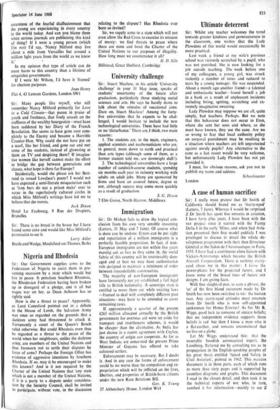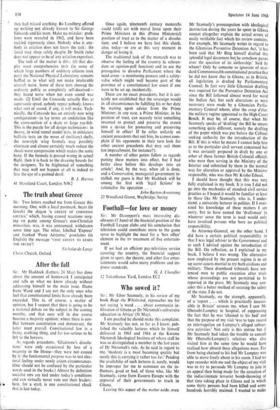A case of human sacrifice
Sir: I really must protest that Dr Smith of California should brand me as 'starry-eyed' (Letters, 7 June). Whereas I would be surprised if Dr Smith has spent five minutes in aviation, I have forty plus years. I have been with the SST project since it started with the Fairey Delta I in the early 'fifties, and when Sud Avia- tion presented their first model publicly I was privileged to discuss in detail the whole de- velopment programme with their then Directeur Gindral at the Salon de l'Adronautique in Paris, 1955. I have had a continuous close liaison with Vickers-Armstrongs which became the British Aircraft Corporation. There is nothing starry- eyed about me in this matter: I know the power-plants for the projected future, and I know some of the broad lines of future SST designs. I am giving facts.
With fine sleight-of-pen, to coin a phrase, the 'us' of the first bland statement made by Dr Smith has now been switched to us: the human race. Any starry-eyed attitudes must emanate from Dr Smith who is now self-appointed spokesman for Homo Erectus! As for Mr R. Wiggs, good luck to someone of sincere beliefs; that no independent evidence supports those beliefs is sad but then I know a man who is a flat-earther, and remains unconvinced that we live on a globe.
Let Mr Wiggs understand this: that the venerable Swedish aeronautical expert, Bo Lundberg, flattered me by consulting me as to propagation in the English-speaking peoples of his great thesis entitled 'Speed and Safety in Civil Aviation', printed in 1962. This massive document is in three parts, each of which runs to more than sixty pages and is supported by countless diagrams and graphs. This document I read in the closest detail, and then took it to the technical experts of BAC who, in turn, combed it for information—mainly to see if 5 they had missed anything. Bo Lundberg offered up nothing not already known to Sir George Edwards and his team. Make no mistake: prob- lems were revealed in 1962, and have been tackled vigorously since. Nobody who is any- body in aviation does not know the task : the timid may sleep safely despite Dr Smith (who does not appear to be of any aviation.expertise).
The nub of the matter is this : (1) that des- pite most comprehensive tests (in some of which large numbers of ordinary citizens took part) the National Physical Laboratory remains baffled as to what will not make intolerable aircraft noise. Some of these tests showed the ordinary public as completely self-deceived- they heard noise when not even sound was made. (2) Until the Concorde actually flies at supersonic speed, nobody repeat nobody, knows what sort of sound, if any, it will make. Tech- nically, the Concorde has an entirely new wing configuration—in lay terms an undulation like the cross-section of a skate or large ray-fish. This is the puzzle for all design technicians: in theory, in wind tunnel model tests, in miniature ballistic tests on the noses of (military) shells, the new-style wing formula may possibily eliminate and almost certainly much reduce the shock-wave compression which makes the sonic bang. If the formula is proved wrong in actual flight, then it is back to the drawing boards for the designers. To be frightened of something that may well not happen at all is indeed to fear the eye of a painted devil.
B. J. Herren 41 Moreland Court, London NW2











































 Previous page
Previous page